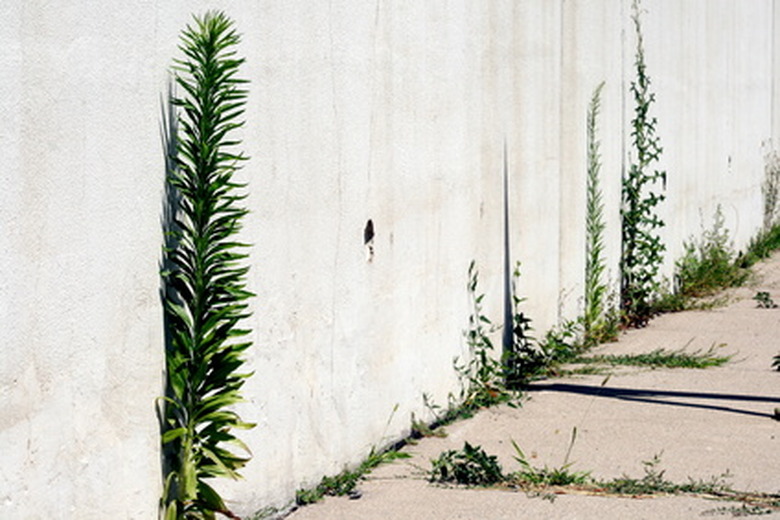The Effect Of Concrete On Plant Growth
Concrete plays a significant role in landscapes, especially public ones that rely on sidewalks or other permanent features like walls, pools or foundations in the overall design. Gardeners and landscapers choose plant materials to visually soften the harsh, geometric lines of concrete forms, making them look more pleasant and soothing.
pH Effects
Among the most widely known consequences of concrete surfaces or debris in a garden setting is increase in pH, making the soil more alkaline, according to the University of Florida. Cement and other aggregates in concrete contain limestone. Ulrich Lorimer writes in "Community Gardening" that water runoff from concrete also supplies nearby plants with altered pH. Alkaline soils limit the availability of certain nutrient ions for plant roots to absorb. Thus, a nutrient deficiency, such as yellowing of leaves occurs in overly alkaline conditions, especially in plants that naturally adapt and grow in acidic soils.
- Concrete plays a significant role in landscapes, especially public ones that rely on sidewalks or other permanent features like walls, pools or foundations in the overall design.
- Ulrich Lorimer writes in "Community Gardening" that water runoff from concrete also supplies nearby plants with altered pH.
- Alkaline soils limit the availability of certain nutrient ions for plant roots to absorb.
Climate Modifications
Concrete warms significantly when exposed to sunlight, more so than vegetation. On a large scale, excessive use of concrete and other hardscape materials in cities creates what is called the "urban heat island." Concrete absorbs the heat from sunlight across the day and then radiates that stored heat back once the sun goes down, keeping temperatures warmer when compared to treed areas of the city or nearby suburbs according to meteorological researchers in "The Impact of the Urban Heat Island during an Intense Heat Wave in Oklahoma City." Thus, concrete that warms in the day can keep nearby plants bathed in warmer temps at night, in summer or winter. Warmer temps can end winter dormancy earlier or allow more heat-loving plants to be grown in regions with cooler summers.
Water Needs
Expanding on the urban heat island phenomenon, when air or soil temperatures are warm, a plant has increased metabolism as well as need for water. A concrete building foundation or patio absorbs and radiates heat during the day to increase air temps and cause nearby plants to wilt. Concrete also is not as permeable as garden soil or other porous landscape materials, so thick concrete layers can block rain and irrigation from reaching roots that grow under the slab.
- Concrete warms significantly when exposed to sunlight, more so than vegetation.
- Concrete absorbs the heat from sunlight across the day and then radiates that stored heat back once the sun goes down, keeping temperatures warmer when compared to treed areas of the city or nearby suburbs according to meteorological researchers in "The Impact of the Urban Heat Island during an Intense Heat Wave in Oklahoma City."
Light Considerations
Colorado State University Extension lists increased reflective light as another issue concrete poses to plants nearby. Light-colored or natural concrete coloration reflects a lot of solar energy. Plants receive light (and heat) from the sun overhead and from any light or heat reflected and intensified by the concrete. This causes the burning of leaf and flower tissues, and increases plant needs for water.
Growth Barriers
Trees grow expansive root systems well beyond the reach of the branches. Some tree species with shallow roots are known to "lift" and create uneven concrete surfaces as the roots grow and enlarge. Conversely, concrete will sustain neither seed germination nor root growth because of its strength and density. Concrete can limit root growth, which is especially helpful in containing aggressive or invasive plant species from spreading via underground rhizome roots or flopping stems that then take root in the soil.
- Colorado State University Extension lists increased reflective light as another issue concrete poses to plants nearby.
- Concrete can limit root growth, which is especially helpful in containing aggressive or invasive plant species from spreading via underground rhizome roots or flopping stems that then take root in the soil.
